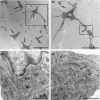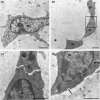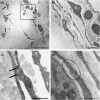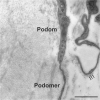Ultrastructural evidence for telocytes in equine tendon
- PMID: 33070316
- PMCID: PMC7855077
- DOI: 10.1111/joa.13335
Ultrastructural evidence for telocytes in equine tendon
Abstract
The three-dimensional ultrastructure of the tendon is complex. Two main cell types are classically supported: elongated tenocytes and ovoid tenoblasts. The existence of resident stem/progenitor cells in human and equine tendons has been demonstrated, but their location and relationship to tenoblasts and tenocytes remain unclear. Hence, in this work, we carried out an ultrastructural study of the equine superficial digital flexor tendon. Although the fine structure of tendons has been previously studied using electron microscopy, the presence of telocytes, a specific type of interstitial cell, has not been described thus far. We show the presence of telocytes in the equine inter-fascicular tendon matrix near blood vessels. These telocytes have characteristic telopodes, which are composed of alternating dilated portions (podoms) and thin segments (podomers). Additionally, we demonstrate the presence of the primary cilium in telocytes and its ability to release exosomes. The location of telocytes is similar to that of tendon stem cells. The telocyte-blood vessel proximity, the presence of primary immotile cilia and the release of exosomes could have special significance for tendon homeostasis.
Keywords: primary cilium; telocytes; tendon; tenocytes; transmission electron microscopy.
© 2020 Anatomical Society.
Conflict of interest statement
The authors confirm that there are no conflicts of interest.
Figures






References
-
- Aleksandrovych, V. , Pasternak, A. , Basta, P. , Sajewicz, M. , Walocha, J.A. & Gil, K. (2017) Telocytes: facts, speculations and myths (Review article). Folia Medica Cracoviensia, 57(1), 5–22. Available from: http://www.ncbi.nlm.nih.gov/pubmed/28608858 [Accessed: 12 December 2019] - PubMed
-
- Benjamin, M. & Ralphs, J.R. (1997) Tendons and ligaments — an overview. Histology and Histopathology, 12(4), 1135–1144. - PubMed
MeSH terms
LinkOut - more resources
Full Text Sources

